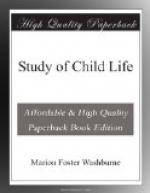By all means, then, encourage the love of reading in your children, and get them the best of story-books to read, and subscribe to the best magazines. Read with them. Let some reading enter into every day’s life; talk over what has been read at the dinner-table, and so avoid harmful personalities and disagreeable criticisms.
[Sidenote: Books]
As to the books to choose, choose the best. Generally speaking, the best are those that have some dignity of age upon them. As in music you chose the folksongs, so in children’s literature also choose the old fashioned fairy stories, such as those collected by the Brothers Grimm and by Andrew Lang. Hans Christian Andersen’s Fairy Stories of course are classics. Hawthorne’s Tanglewood Tales give excellent suggestions as to the right use to be made of the old mythologies. Many of the supplementary readers now being so widely used in the public schools are good, simple versions of these old stories which helped to make the world what it should be. For the rest there are two standard children’s magazines which help to form a good taste in literature and which are continually suggestive of the right sort of reading material. These are The Youth’s Companion and St. Nicholas.
[Sidenote: Nature Study]
Finally, all appreciation of literature and art depends upon a love of and some knowledge of nature. Fairy stories and mythology especially are so dependent upon nature for their inner meaning and significance as scarcely to be intelligible without some knowledge of natural processes and laws. Of course, it is true that art in its turn idealizes nature and fills her beautiful form with a beautiful soul; so that the child who is being developed on all sides needs to take his books and his pictures out of doors in order to get the full good of them.
[Sidenote: Art and Nature]
No amount of music, art, and literature can make up for the free life in the fields and under the sky which all these arts describe and interpret. If he should be so unhappy as to have to choose between nature and art, it would be better for him to choose nature, because then, perhaps, art might be born in his own soul. But there is happily no need for such a painful choice. He can sing his little song out of doors with the birds and notice how they join in the chorus. He can paint evening sunsets with the pine-trees against it far better out of doors than indoors with copy perched before him. He can look down the aisles of the real woods to watch for the enchanted princess, or for the chivalrous knight whose story he is reading. Art and nature belong together in the unified soul of the child. Well for him and for the world in which he lives if they are never divorced, but he goes on to the end loving them both and seeing them both as one.




